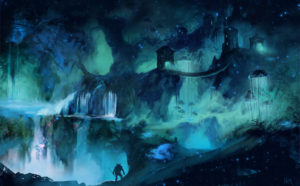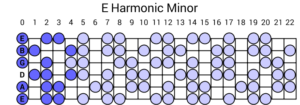Somber Lands: The Harmonic Minor Scale (original) (raw)

Dark, brooding, and long cloaked in obscurity, the harmonic minor scale is a compelling collective of notes that has historically been used as an accent to minor key compositions. For centuries only a handful of pieces had been written within its bounds as composers instead opted to weave in for a number of measures before an eventual progression into the natural minor scale. From there it appeared again in a few folk songs, took a strong spiritual presence in Islamic culture, and later became an integral part of horror movies when they progressed into the frightening mediums they became in the 1970s. But it wasn’t until the musicians of the early Swedish death metal scene discovered how to fully harness the scale’s potential that lengthy songs and even the majority of some albums began being composed within its bounds. A truly grotesque wedlock, the scale gave he who wielded it the power to craft the most sinister and foreboding compositions possible within the laws of music. It is for this reason one could attest that the minor harmonic scale has found a home in heavy metal that no other genre of music could provide.
A mere semitone difference than the natural minor scale, the minor harmonic scale features a bold whole-and-a-half step jump as the seventh tone becomes an augmented second nestled right beside the octave. This offers countless metal-and-horror-friendly melodies through the two half step intervals as well as the aforementioned whole-and-a-half step that is especially friendly to power chord slides. More so, there are many “sister” scales that are a note apart from the minor harmonic scale- the natural minor, melodic minor, blues minor, and gypsy scale offer an immense volume of compositional supplements as riffs/motifs intertwine within them quite favorably. In fact, nearly every step of the minor harmonic scale can be moved a fret or two apart to utilize dissonant tones that will more often than not compliment its power- an especially useful tool when playing metal with distorted electric guitars.
Many classical pieces have utilized the minor harmonic scale at times, though almost always fading into natural minor directly before or after. The opening moments of Mozart’s Symphony No. 25 and Bach’s Invention #4 are strong and storied moments for the scale, but a truly outstanding example comes to be in what could be considered to be the most metal piece in all of classical music- the climactic Presto agitato movement that concludes Beethoven’s epic Moonlight Sonata (above). Through this ravaging masterpiece of 19th century death metal debauchery, Beethoven savages the listener with some insanely vicious piano riffs like the ones at 0:34 and 1:26. Storming with melancholic aggression, these movements prove just how efficiently harmonic minor melodies can be at extreme tempos and complexity.
https://www.youtube.com/watch?v=8ImWVl8hL00
Flash forward almost two hundred years, and the daring use of minor harmonic scale would be harvested by the greatest generation of black and death metal acts the world has known to date. While many in the Swedish death metal scene found use of minor harmonic scales and motifs a part of their repertoire, Dissection would set a bold new precedent as they rooted them into the core of their being. Though they too, would on occasion wade into natural minor (the more “classical heavy metal” type riffs), gypsy scale riffs (e.g. the intro to “Frozen” or the melody of “At the Fathomless Depths”), and utter dissonance (“In the Cold Winds of Nowhere”), Dissection’s use of dominant minor harmonic scale melodies on the Storm of the Night’s Bane album was the absolute essence of their legacy. Nearly every riff in “Unhallowed” and “Retribution: Storm of the Night’s bane” is in minor harmonic, and the most memorable moments of the classic “Where Dead Angels Lie” is draped in harmonic minor mastery. Creating visceral masterpieces sonic majesty, Dissection most memorably used the harmonic minor scale to crate some of the best death metal the world has ever known. Their countrymen followed suit, making the melodic use of the harmonic minor scale the bloodline of Swedish death metal.
https://www.youtube.com/watch?v=pqYh1lI3QDk
On the black metal front, the harmonic minor scale was concurrently becoming a cornerstone of its sound, though through a much simplified utilization of textural brushstroke rather than bombastic technical grit. Much in the way Sweden’s death metal scene embraced the minor harmonic scale with newfound passion and innovation, so too France’s black metal movement made it a staple of their sound. Though I desperately wanted to use a Mutiilation song to articulate this- being that they are the foundation of the country’s black metal and perhaps its finest hour- I quickly realized most listeners would struggle to discern the notes buried deep within the static of those monumental albums. Thus, let us look to the cleaner sound of Celestia to understand the minor harmonic scale’s dominant presence in French black metal. Through this piece and virtually all of their songs, bands like Celestia and Mutiilation resort to minor harmonic exclusively to create a world of hopelessness, loss and despair. Utilizing two note intervals in place of arpeggiated melodies, the cold-hearted musicians of France used a more minimalist form of the harmonic minor scale to deliver a fresh and effective portrayal of death and darkness entombed within its bounds.

All of the notes in the harmonic scale in whatever tuning your guitar is in
Though most often think of the penatatonic and/or chromatic scale as “the metal scale,” the harmonic minor scale has an equally important place in the genre’s history. With its haunting melodies and colossal power, the minor harmonic scale has been one of the most important ingredients in death and black metal alike. Thus, it should be an oft used weapon of any musician looking to continue the storied legacy of these genres. In fact, it should perhaps be the said musician’s weapon of choice- for it has brought limitless compositional successes to those who have.
Tags: Beethoven, Black Metal, celestia, classical music, death metal, dissection, harmonic minor, minor key, music theory, mütiilation